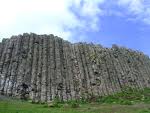![]() Giantís Causeway
Giantís Causeway
 ďGiantís
Causeway, with its unusual formations, attracts thousands of visitors each year
to Northern Ireland. Some geologists claim that the Causeway was formed over 60
million years ago by intermittent periods of volcanic activity. But other
geologists, who approach Giantís Causeway with a biblical understanding of the
past, state that this wonder was formed around 4,500 years ago as a result of a
single, great catastrophe.
ďGiantís
Causeway, with its unusual formations, attracts thousands of visitors each year
to Northern Ireland. Some geologists claim that the Causeway was formed over 60
million years ago by intermittent periods of volcanic activity. But other
geologists, who approach Giantís Causeway with a biblical understanding of the
past, state that this wonder was formed around 4,500 years ago as a result of a
single, great catastrophe.
 The Causeway
basalts are made up of seven separate lava flows and vary in height from 330
feet (100 m) down to the waterís edge. These layers were produced as a result of
the earthís plates shifting. These movements created great openings in the
earthís crust, through which lava rushed out and covered the land. This
intermittent tectonic activity generated the different layers of lava that are
found in this area. Each layer of lava was hardened by water before being
covered by another layer. The 40,000 or more, mostly six-sided, columns of
Giantís Causeway give evidence to this cooling. The columns formed as the lava
began to cool from both the top and bottom of the lava pool. As these surfaces
hardened, they contracted, creating deep cracks all along the surface of the
lava pool. The lava then continued to cool and contract which, in turn, extended
the cracks vertically until they finally connected, forming columns.
The Causeway
basalts are made up of seven separate lava flows and vary in height from 330
feet (100 m) down to the waterís edge. These layers were produced as a result of
the earthís plates shifting. These movements created great openings in the
earthís crust, through which lava rushed out and covered the land. This
intermittent tectonic activity generated the different layers of lava that are
found in this area. Each layer of lava was hardened by water before being
covered by another layer. The 40,000 or more, mostly six-sided, columns of
Giantís Causeway give evidence to this cooling. The columns formed as the lava
began to cool from both the top and bottom of the lava pool. As these surfaces
hardened, they contracted, creating deep cracks all along the surface of the
lava pool. The lava then continued to cool and contract which, in turn, extended
the cracks vertically until they finally connected, forming columns.
Evolutionary geologists have attempted to date rocks found in Giantís Causeway
by using a process called radiometric dating, and have obtained a date of about
60 million years. However, radiometric dating is known to be flawed and is based
on many unproved assumption. One catastrophic event that gives more evidence to
this faulty dating process is the explosion of Mount St. Helens in the
northwestern USA. When rock that was formed from that eruption was tested, the
results yielded ďdatesĒ up to several million years, when in reality the rock
was just twenty years old.

The conditions of the Flood described in the Bible provide an explanation for
the formation of Giantís Causeway. Several months into Noahís Flood, the
sedimentary strata now found in Northern Ireland had been deposited by the
violent currents of the Flood waters. Then late in the Flood, as the waters
began receding, volcanic activity covered the sedimentary strata with thin
layers of lava. This lava then hardened as it cooled. As the tectonic activity
paused, the waters briefly covered the area again, depositing floating mats of
vegetation and other sediment on the lava surface. Within days, the tectonic
activity continued, resulting in the layers of lava and sediment being covered
with another layer of lava. This rapid cycle of volcanic and tectonic activity
with water surges resulted in the columns and cliffs we see in Giantís Causeway
today.
Scientists who accept the biblical record date the Genesis Flood to about 4,500
years ago, rather than believing the millions of years determined by the faulty
radiometric dating methods. Giantís Causeway stands as a testimony to a time
when God judged the wickedness of mankind, but protected those on the Ark who
obeyed Him.Ē Full text: Creation Road Trip
http://www.answersingenesis.org/articles/am/v1/n1/creation-road-trip-more
![]() Giantís Causeway
Giantís Causeway